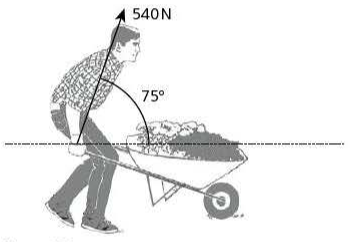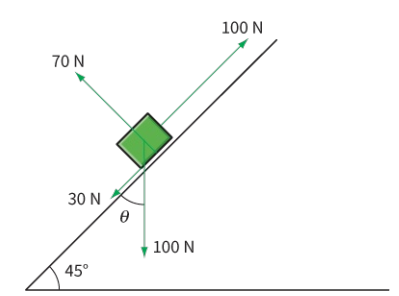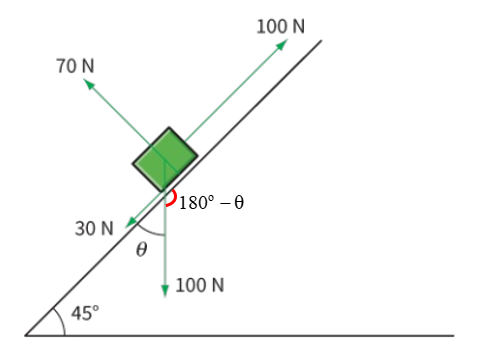Question 1
Figure shows a man wheeling a barrow. He applies a force of 540 N to the barrow in a direction 75o from the horizontal. He moves the barrow 30 m along level ground. Calculate the work he does against friction.

Easy
Mark as Complete
Mark Scheme
Question 2
A man lifts a weight of 480 N through a vertical distance of 3.5 m using a rope and some pulleys. The man pulls on the rope with a force of 200 N and a length of 10.5 m of rope passes through his hands. Calculate the efficiency of the pulley system.
Easy
Mark as Complete
Mark Scheme
Question 3
Name each of the following types of energy:
a. Energy used in muscles.
b. Energy of water in a mountain lake.
c. Energy captured by a wind turbine.
d. Energy produced when a firework explodes.
e. Energy of a compressed gas.
Easy
Mark as Complete
Mark Scheme
Question 4
In each case a–c, describe the energy changes taking place:
a. An apple falling towards the ground.
b. A car decelerating when the brakes are applied.
c. A space probe falling towards the surface of a planet.
Easy
Mark as Complete
Mark Scheme
Question 5
An elastic band is stretched so that its length increases by 2.4 cm. The force required to stretch the band increases linearly from 6.3 N to 9.5 N. Calculate:
a. The average force required to stretch the elastic band,
b. The work done in stretching the band.
Medium
Mark as Complete
Mark Scheme
Question 6
A petrol motor is used to lift a bag of sand of mass 2700 kg from the ground up to a window 12 m above the ground. Eighteen per cent of the input energy is converted into gravitational energy of the sand.
a. Calculate the energy input to the motor.
b. Discuss the energy changes involved in the process.
Medium
Mark as Complete
Mark Scheme
Question 7
Figure shows the forces acting on a box that is being pushed up a slope. Calculate the work done by each force if the box moves 0.50 m up the slope.

Medium
Mark as Complete
Mark Scheme
Question 8
A lift in a shopping centre can transport 20 people to a height of 54 m in a time of 14 s. The lift compartment has a mass of 1420 kg and the average person has a mass of 60 kg.
a. Calculate the combined mass of the compartment and the 20 people in it.
b. Calculate the energy gained as the lift travels upwards.Think about the lif as it rises. Which form of energy is increasing?
c. Calculate the rate at which energy is transferred by the lift motor to the compartment.
Medium
Mark as Complete
Mark Scheme
Question 9
A car moves along a horizontal road with a constant velocity v against a resistive force F. The engine of the car has an efficiency of 25%. What is the input power to the engine?
A. `(F v) / 4.0`
B. `4.0 / (F v)`
C. `4.0 F v`
D. `(4.0 F) / v`
Medium
Mark as Complete
Mark Scheme
Question 10
In order to strengthen her legs, an athlete steps up on to a box and then down again 30 times per minute. The girl has mass 50 kg and the box is 35 cm high. The exercise lasts 4.0 minutes and as a result of the exercise, her leg muscles generate 120 kJ of heat energy. Calculate the efficiency of the leg muscles (g = 9.81 m.s–2).
Hard
Mark as Complete
Mark Scheme
Question 1
Figure shows a man wheeling a barrow. He applies a force of 540 N to the barrow in a direction 75o from the horizontal. He moves the barrow 30 m along level ground. Calculate the work he does against friction.

`"Work done" = F xx costheta = 540 xx 30 xx cos(75) = "4200 J"`
Question 2
A man lifts a weight of 480 N through a vertical distance of 3.5 m using a rope and some pulleys. The man pulls on the rope with a force of 200 N and a length of 10.5 m of rope passes through his hands. Calculate the efficiency of the pulley system.
`"Work done by man" = "force" xx "distance moved (in direction of the force)" = 200 xx 10.5 = "2100 J"`
`"Work done lifting load" = 480 xx 3.5 = "1680 J"`
`"Efficiency" = "total output work" / "total input work" = 1680 / 2100 = 0.80 " or " "80%"`
Question 3
Name each of the following types of energy:
a. Energy used in muscles.
b. Energy of water in a mountain lake.
c. Energy captured by a wind turbine.
d. Energy produced when a firework explodes.
e. Energy of a compressed gas.
a. Kinetic energy at its lowest point → potential energy at its highest point → kinetic energy at its lowest point, etc. (kinetic and potential energy at points in between).
b. Potential energy of compressed gas → kinetic energy of spray droplets → heat when droplets have stopped moving(energy transferred to surrounding atmosphere).
c. Kinetic energy when thrown → potential and kinetic energy at highest point of motion → internal and heat and sound energy when clay hits the ground.
d. Chemical potential energy in the firework → kinetic energy of fragments and expanding gases → light and sound energy → eventually heat energy transferred to the surroundings.
e. Potential energy stored in the compressed gas → converted to kinetic energy of expanding gas when released → then to internal energy and heat as the gas mixes with surrounding air.
Question 4
In each case a–c, describe the energy changes taking place:
a. An apple falling towards the ground.
b. A car decelerating when the brakes are applied.
c. A space probe falling towards the surface of a planet.
a. Loss of gravitational potential energy → gain in kinetic energy.
b. Kinetic energy → heat (in the brakes).
c. Loss of gravitational potential energy → gain in kinetic energy.
Question 5
An elastic band is stretched so that its length increases by 2.4 cm. The force required to stretch the band increases linearly from 6.3 N to 9.5 N. Calculate:
a. The average force required to stretch the elastic band,
b. The work done in stretching the band.
a. Since the force increases linearly, the average force:
`F_(avg) = (F_1 + F_2) / 2 = (6.3 + 9.5) / 2 = "7.9 N"`
b. `Work = F_(avg) xx "extension" = 7.9 xx 0.024 = "0.1896 J" ~~ "0.19 J"`
Question 6
A petrol motor is used to lift a bag of sand of mass 2700 kg from the ground up to a window 12 m above the ground. Eighteen per cent of the input energy is converted into gravitational energy of the sand.
a. Calculate the energy input to the motor.
b. Discuss the energy changes involved in the process.
a.
`"Efficiency" = "useful work done" / "energy input" xx 100%`
`"Useful work done" = mxx g xxh = 2700 xx 9.8 xx 12 = "317520 J"`
`18 = 317520 / "energy input" xx 100%`
`"Energy input" = (317520 xx 100) / 18 = "1764000 J" ~~ "1.8 MJ"`
b. The chemical potential energy of the petrol is converted into internal energy in the motor and 18% of this is used to do work against gravity in lifting the sand. The remainder is transferred to the surroundings as they are heated.
Question 7
Figure shows the forces acting on a box that is being pushed up a slope. Calculate the work done by each force if the box moves 0.50 m up the slope.

`"Work done by force up slope:" " " W = F xx s xxcostheta = 100 xx 0.50 xx1 = "50 J"`
`"Work done by normal force" = 70xx 0.5xx cos90^o = "0 J"`
`"Work done by force down slope:" " " W = F xx s xxcostheta = 30 xx 0.50xxcos180^o = "-15 J"`
`"Work done by gravity:" " " W = F xx s xxcosalpha = 100 xx 0.5xx cos(180^o-theta) ~~ "-35 J"`
 Note: `theta` is angle between direction of motion and direction of force.
Note: `theta` is angle between direction of motion and direction of force.
Question 8
A lift in a shopping centre can transport 20 people to a height of 54 m in a time of 14 s. The lift compartment has a mass of 1420 kg and the average person has a mass of 60 kg.
a. Calculate the combined mass of the compartment and the 20 people in it.
b. Calculate the energy gained as the lift travels upwards.Think about the lif as it rises. Which form of energy is increasing?
c. Calculate the rate at which energy is transferred by the lift motor to the compartment.
a.
`"Mass of 20 people" = 20 xx 60 = "1200 kg"`
`"Total mass" = 1420 + 1200 = "2620 kg"`
b.
The form of energy increasing is gravitational potential energy.
`GPE = m xxgxx h = 2620 xx 9.81 xx 54 = "1386089 J"`
c.
Rate at which energy is transferred = power.
`Power = "Energy" / "Time" = 1386089 / 14 ~~ "99006 W"`
Question 9
A car moves along a horizontal road with a constant velocity v against a resistive force F. The engine of the car has an efficiency of 25%. What is the input power to the engine?
A. `(F v) / 4.0`
B. `4.0 / (F v)`
C. `4.0 F v`
D. `(4.0 F) / v`
Answer: C
`"Efficiency" = "useful power output" / "input power"`
`=> "Input power" = "useful power output" / "efficiency" = F v / 0.25 = 4.0 F v`
Question 10
In order to strengthen her legs, an athlete steps up on to a box and then down again 30 times per minute. The girl has mass 50 kg and the box is 35 cm high. The exercise lasts 4.0 minutes and as a result of the exercise, her leg muscles generate 120 kJ of heat energy. Calculate the efficiency of the leg muscles (g = 9.81 m.s–2).
`"GPE per step" = mxx gxx h = 50 xx 9.81 xx 0.35 = 171.675 " " J`
Since she does it 30 times every minute and does for 4 minutes total, then `171.675xx30xx4="21000 J"`
21000 J is useful energy.
The total energy is the useful energy plus the energy wasted as heat energy which is 120000 J.
Hence, the total energy = 21000 J + 120000 J = 141000 J.
`"Efficiency" = 21000 / 141000 xx 100 = "14.89%"`
Question 1
Figure shows a man wheeling a barrow. He applies a force of 540 N to the barrow in a direction 75o from the horizontal. He moves the barrow 30 m along level ground. Calculate the work he does against friction.

Question 2
A man lifts a weight of 480 N through a vertical distance of 3.5 m using a rope and some pulleys. The man pulls on the rope with a force of 200 N and a length of 10.5 m of rope passes through his hands. Calculate the efficiency of the pulley system.
Question 3
Name each of the following types of energy:
a. Energy used in muscles.
b. Energy of water in a mountain lake.
c. Energy captured by a wind turbine.
d. Energy produced when a firework explodes.
e. Energy of a compressed gas.
Question 4
In each case a–c, describe the energy changes taking place:
a. An apple falling towards the ground.
b. A car decelerating when the brakes are applied.
c. A space probe falling towards the surface of a planet.
Question 5
An elastic band is stretched so that its length increases by 2.4 cm. The force required to stretch the band increases linearly from 6.3 N to 9.5 N. Calculate:
a. The average force required to stretch the elastic band,
b. The work done in stretching the band.
Question 6
A petrol motor is used to lift a bag of sand of mass 2700 kg from the ground up to a window 12 m above the ground. Eighteen per cent of the input energy is converted into gravitational energy of the sand.
a. Calculate the energy input to the motor.
b. Discuss the energy changes involved in the process.
Question 7
Figure shows the forces acting on a box that is being pushed up a slope. Calculate the work done by each force if the box moves 0.50 m up the slope.

Question 8
A lift in a shopping centre can transport 20 people to a height of 54 m in a time of 14 s. The lift compartment has a mass of 1420 kg and the average person has a mass of 60 kg.
a. Calculate the combined mass of the compartment and the 20 people in it.
b. Calculate the energy gained as the lift travels upwards.Think about the lif as it rises. Which form of energy is increasing?
c. Calculate the rate at which energy is transferred by the lift motor to the compartment.
Question 9
A car moves along a horizontal road with a constant velocity v against a resistive force F. The engine of the car has an efficiency of 25%. What is the input power to the engine?
A. `(F v) / 4.0`
B. `4.0 / (F v)`
C. `4.0 F v`
D. `(4.0 F) / v`
Question 10
In order to strengthen her legs, an athlete steps up on to a box and then down again 30 times per minute. The girl has mass 50 kg and the box is 35 cm high. The exercise lasts 4.0 minutes and as a result of the exercise, her leg muscles generate 120 kJ of heat energy. Calculate the efficiency of the leg muscles (g = 9.81 m.s–2).